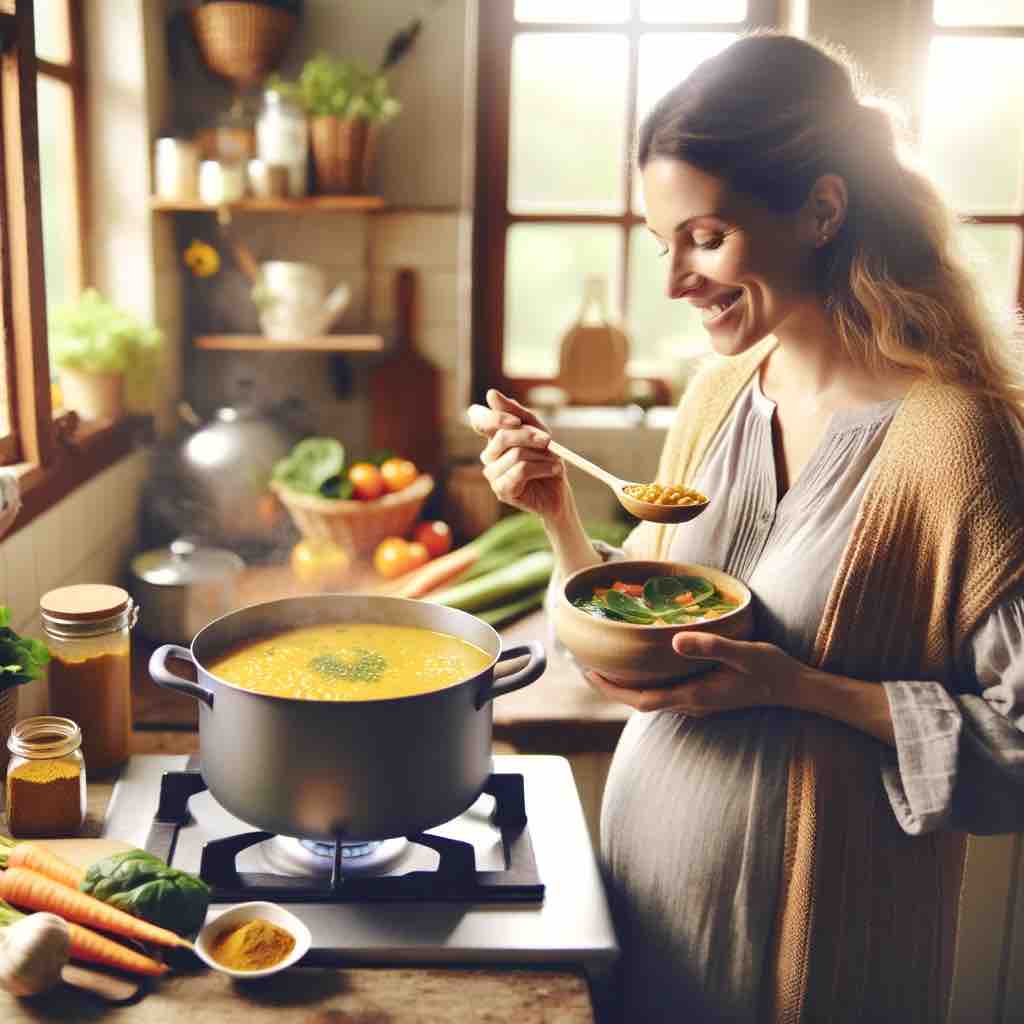
When a snack is more than just a snack
Pregnancy changes the way you think about food. It’s not just about taste anymore — every bite feels like it matters.
Some nights you’re craving something warm and comforting. Other days, you need an energy boost to get through a busy afternoon. And sometimes, you’re simply hungry — again — even though you just ate two hours ago.
These moments are where smart snacking comes in. Snacks can either be empty calories… or they can be little nutrient powerhouses that support your baby’s development, your energy levels, and your overall well-being.
One of the smartest snack pairings for expecting mothers? Chicken + Quinoa.
Why Your Body Craves Iron During Pregnancy
Your blood volume rises by as much as 50% during pregnancy. To handle this, your body needs more hemoglobin — and hemoglobin’s core building block is iron.
The daily goal:
Pregnant women need ~27 mg of iron per day (as per WHO and ACOG guidelines).
If you fall short:
- You may feel fatigue, weakness, or dizziness.
- You could develop iron-deficiency anemia.
- Your baby’s growth and birth weight could be affected.
💡 Learn more in our deep dive: Anemia in Pregnancy: Impact and Solutions
The Chicken + Quinoa Advantage
This combo is a nutritional double act:
- Chicken → A rich source of heme iron (easier to absorb) and choline, which supports fetal brain development.
- Quinoa → A plant-based source of non-heme iron (~2.8 mg per cup cooked), folate, magnesium, and complete protein — rare for a plant food.
- Together → You get two forms of iron in one snack, improving your total absorption. Pair with vitamin C (lemon, bell peppers, tomatoes) and you get even more bang for your bite.
And it’s versatile — from warm soups to crunchy patties, the possibilities are endless.
Snack Science: Making Iron Work Harder
From our research:
- Vitamin C boosts absorption of non-heme iron — just 25 mg (the amount in a small wedge of lemon) can make a noticeable difference.
- The “meat factor” from chicken also improves absorption of plant-based iron from quinoa and veggies.
- Avoid tea, coffee, or dairy within 1–2 hours of your iron-rich snacks — tannins and calcium can block absorption.
5 Energizing Chicken & Quinoa Snacks
Below, each idea is written as a mini recipe — with flavors, nutrition notes, and easy prep tips.
1. Grilled Chicken & Quinoa Salad with Bell Peppers
Iron per serving: ~2.5–3 mg
Prep time: 15 minutes
Ingredients:
- ½ cup cooked quinoa (~1.4 mg iron)
- 100 g grilled chicken breast (heme iron source)
- ½ red bell pepper (vitamin C boost)
- Olive oil, lemon juice, salt, pepper
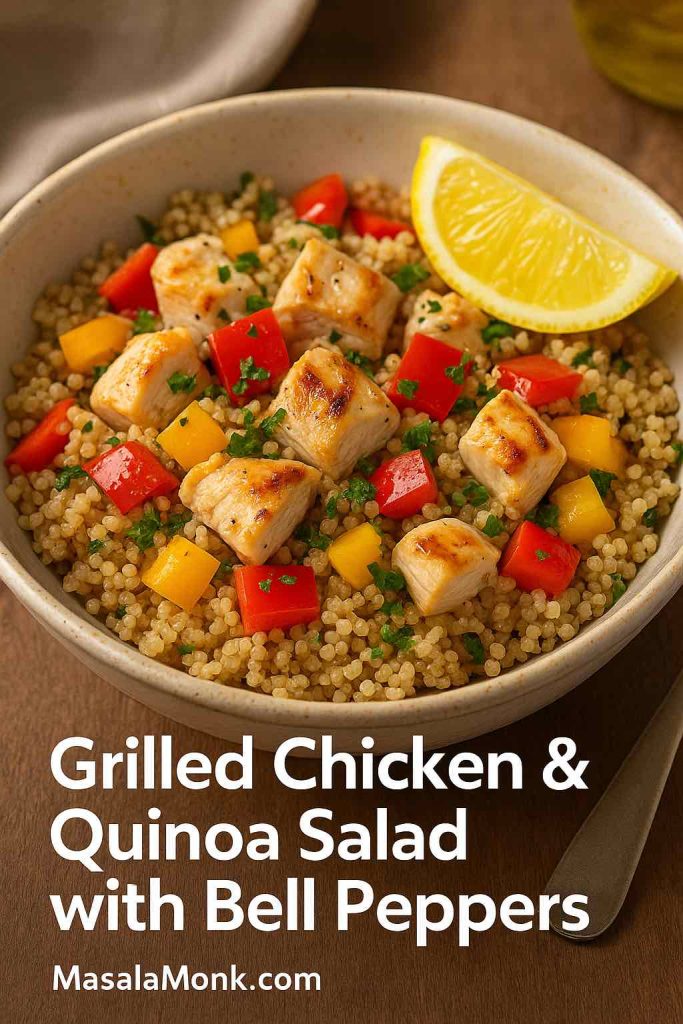
Method:
- Toss cooked quinoa and diced chicken in a mixing bowl.
- Add chopped bell peppers for crunch and vitamin C.
- Drizzle with olive oil and squeeze lemon juice over the top.
Why it works: Combines heme + non-heme iron with vitamin C for max absorption.
2. Chicken-Quinoa Soup with Spinach & Lemon
Iron per serving: ~3 mg
Prep time: 20 minutes
Ingredients:
- ½ cup cooked quinoa
- 100 g shredded chicken
- 1 cup chicken broth
- 1 cup fresh spinach leaves
- Juice of ½ lemon
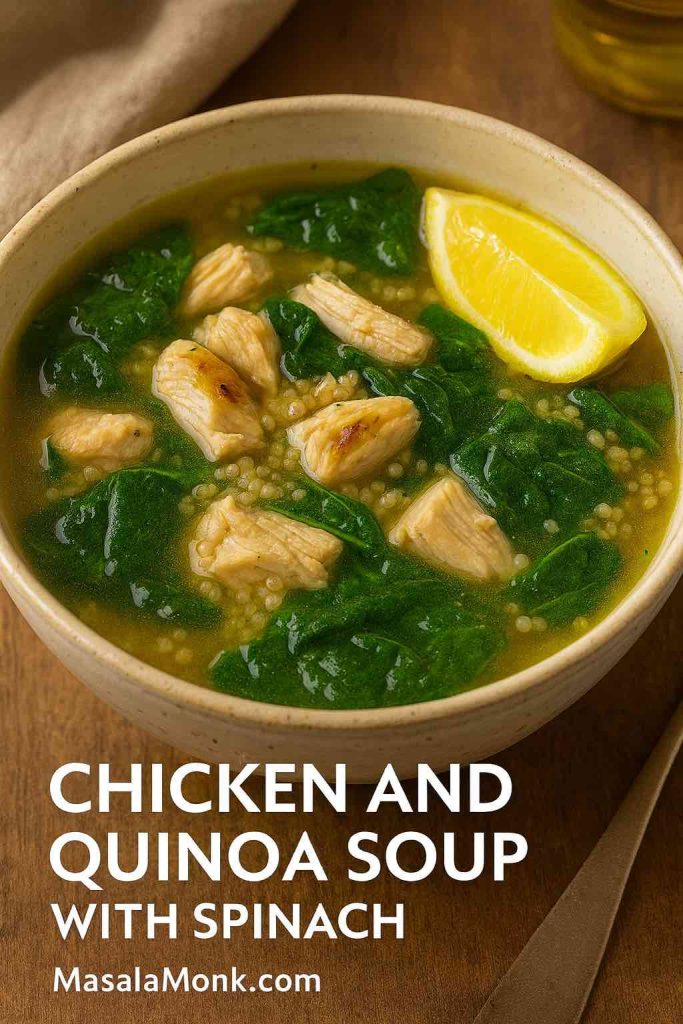
Method:
- Bring broth to a gentle boil.
- Add quinoa and shredded chicken, simmer for 5 minutes.
- Stir in spinach until wilted.
- Finish with lemon juice before serving.
🔗 Love greens? Try our 5 Folate Rich Salads for Pregnant Women with Kale, Quinoa, and Beets for more folate + iron ideas.
3. Quinoa-Chicken Bowl with Avocado & Tomatoes
Iron per serving: ~2.8 mg
Prep time: 10 minutes
Ingredients:
- ½ cup warm quinoa
- 100 g grilled chicken strips
- ½ avocado (healthy fats)
- ½ cup cherry tomatoes (vitamin C)
- 1 tbsp sesame seeds (~1.3 mg iron)
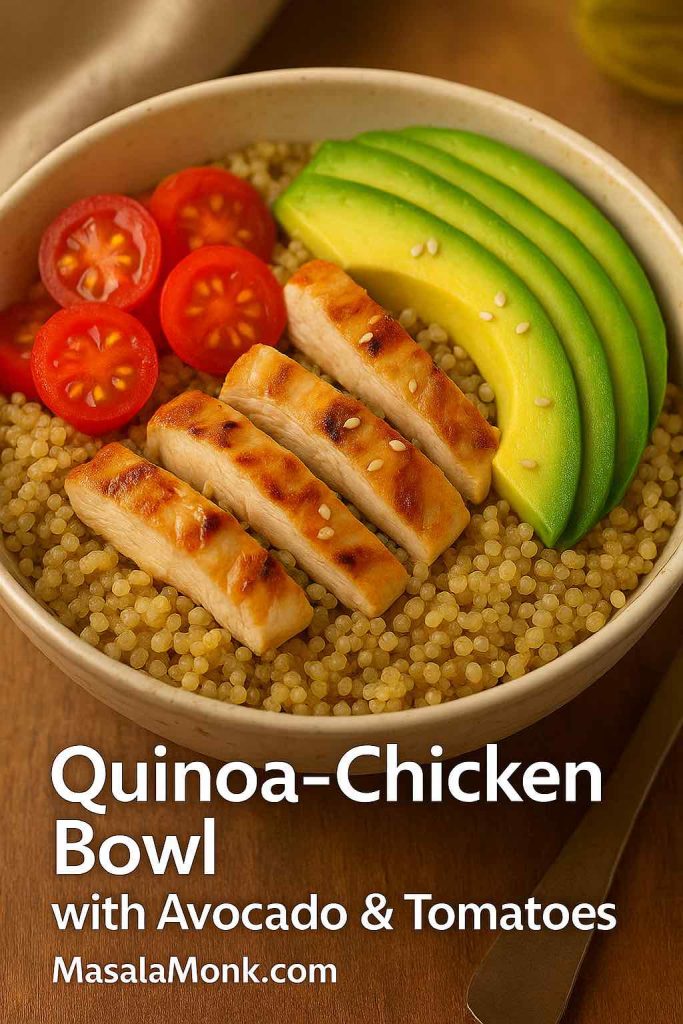
Method:
- Layer quinoa, chicken, avocado slices, and cherry tomatoes.
- Sprinkle sesame seeds over the top.
4. Mini Chicken-Quinoa Patties with Tomato Salsa
Iron per serving: ~2.5 mg
Prep time: 25 minutes
Ingredients:
- ½ cup cooked quinoa
- 100 g shredded chicken
- 1 egg (binder)
- Herbs & spices of choice
- Fresh tomato salsa
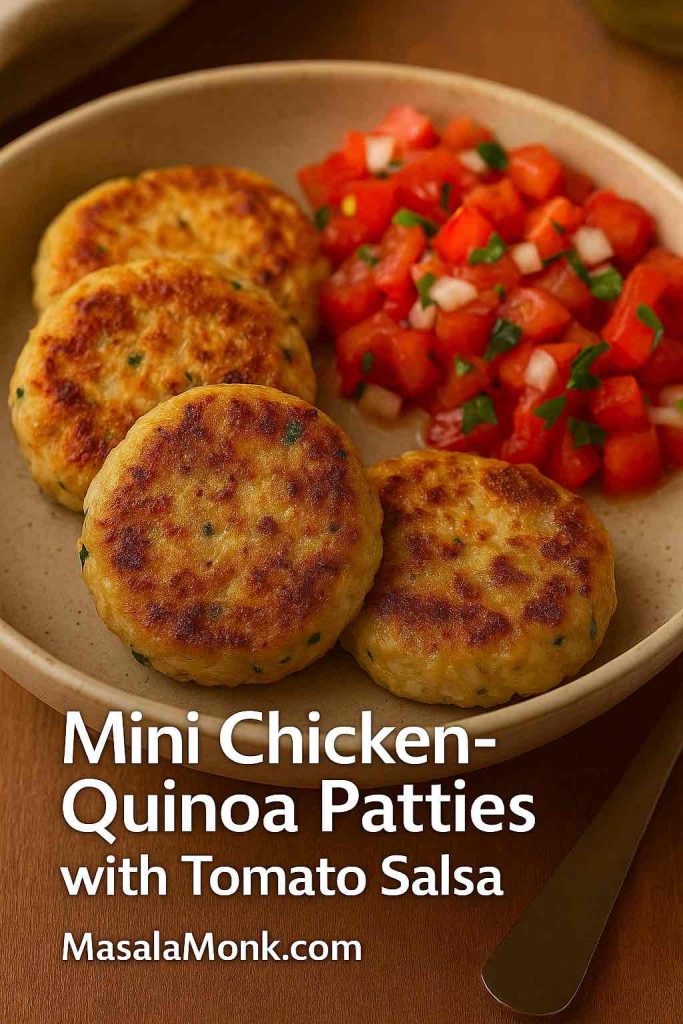
Method:
- Mix quinoa, chicken, egg, and seasoning.
- Form small patties and pan-fry until golden on each side.
- Serve with tomato salsa for vitamin C.
💡 Many moms in our community batch-cook these on weekends for grab-and-go snacks.
5. Quinoa & Chicken Wrap with Fresh Greens
Iron per serving: ~2.5 mg
Prep time: 10 minutes
Ingredients:
- ½ cup quinoa
- 100 g chicken (grilled or shredded)
- Lettuce, bell peppers
- Whole-wheat or gluten-free wrap
- Lime juice

Method:
- Fill wrap with quinoa, chicken, greens, and peppers.
- Squeeze lime juice for extra flavor and vitamin C.
- Roll tight and enjoy.
Smart Pairings for Maximum Iron
- Do: Add lemon, bell peppers, guava, or tomatoes for vitamin C.
- Avoid: Drinking tea/coffee or eating high-calcium foods immediately after.
- Mix: Use both heme and non-heme sources daily for balanced intake.
For more plant-powered inspiration, see 5 Iron-Boosting Vegan Snacks for Pregnancy: Lentil and Spinach Combinations
The Bottom Line
Chicken and quinoa aren’t just “healthy” — together, they’re a pregnancy super-snack. They give you two types of iron, steady energy, complete protein, and plenty of flavor.
Whether you enjoy them in a warm soup, fresh salad, or portable wrap, these snacks are proof that eating for two can be delicious, practical, and nutrient-rich.
Frequently Asked Questions
1. Why is iron so important during pregnancy?
Iron supports the production of hemoglobin, which carries oxygen in your blood. During pregnancy, your blood volume increases significantly, and meeting your iron needs helps prevent anemia, supports energy levels, and aids your baby’s growth and brain development.
2. How much iron do I need each day when pregnant?
Most health guidelines, including WHO and ACOG, recommend around 27 mg of iron daily for pregnant women. This includes both dietary iron and any supplements your doctor may advise.
3. What’s the difference between heme and non-heme iron?
Heme iron comes from animal foods like chicken, and is absorbed more efficiently by the body. Non-heme iron is found in plant-based foods like quinoa, spinach, and legumes, and benefits greatly from being paired with vitamin C for better absorption.
4. Why combine chicken and quinoa in snacks?
This pairing gives you both heme and non-heme iron in one meal, improving your overall absorption. Quinoa also adds folate, fiber, and complete plant protein to chicken’s iron and choline content.
5. How can I make sure my body absorbs the most iron from these snacks?
Pair them with vitamin C-rich foods like lemon juice, bell peppers, or tomatoes. Avoid tea, coffee, or calcium-rich dairy within 1–2 hours of eating your iron-rich snack.
6. Are chicken and quinoa safe for all stages of pregnancy?
Yes — as long as the chicken is thoroughly cooked and the quinoa is properly rinsed and cooked. This makes them safe, nutrient-rich choices from the first trimester through postpartum.
7. Can I meal prep these snacks ahead of time?
Absolutely. Cook chicken and quinoa in bulk, store them separately in airtight containers in the fridge, and assemble your snacks when needed. Patties and wraps are especially meal-prep friendly.
8. What are some quick variations if I don’t have time to cook?
Use leftover roast chicken, canned low-sodium chicken, or pre-cooked quinoa. Add fresh greens, pre-cut bell peppers, and a squeeze of lemon for a fast nutrient boost.
9. Is quinoa gluten-free?
Yes. Quinoa is naturally gluten-free, making these snacks a good choice for those with gluten sensitivity or celiac disease.
10. Can these snacks help with pregnancy fatigue?
Yes. Fatigue is a common symptom of low iron. Snacks that combine both types of iron, plus protein and complex carbs, can help maintain steady energy levels between meals.

